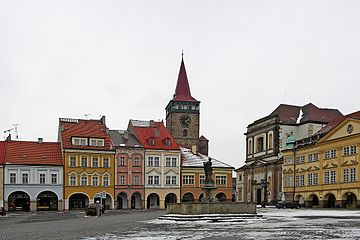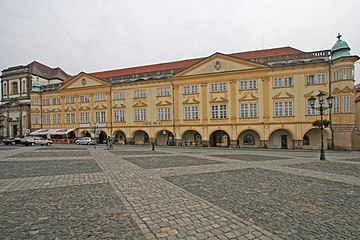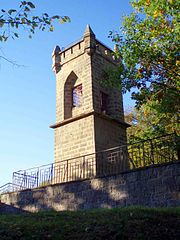Jičín
| Jičín | ||||
|---|---|---|---|---|
|
||||
| Basic data | ||||
| State : |
|
|||
| Region : | Královéhradecký kraj | |||
| District : | Jičín | |||
| Area : | 2493 ha | |||
| Geographic location : | 50 ° 26 ' N , 15 ° 21' E | |||
| Height: | 287 m nm | |||
| Residents : | 16,577 (Jan 1, 2019) | |||
| Postal code : | 506 01 | |||
| License plate : | H | |||
| traffic | ||||
| Railway connection: |
Veleliby – Jičín Ostroměř – Jičín Jičín – Turnov |
|||
| structure | ||||
| Status: | city | |||
| Districts: | 11 | |||
| administration | ||||
| Mayor : | Jan Malý (as of 2011) | |||
| Address: | Žižkovo nám. 18 506 01 Jičín |
|||
| Municipality number: | 572659 | |||
| Website : | www.mujicin.cz | |||
Jičín (German Jitschin , formerly Gitschin ) is a small town in the Hradec Králové region in the Czech Republic . It is the capital of the Okres Jičín . From 1625 to 1634 the place was expanded to the seat of the former Duchy of Friedland .
geography
The city is located on the Cidlina river around 80 kilometers northeast of Prague on the edge of the Bohemian Paradise Protected Landscape Area . A large thoroughfare connects the place with Prague and the Giant Mountains . There are also good connections to Mladá Boleslav , Turnov and Hradec Králové .
history
The place was probably created at the end of the 12th century, but no foundation document has been preserved. The original settlement was in the area of today's Staré Místo ( Old Square ), below the Veliš Castle . However, it was later moved three kilometers north to the bank of the Cidlina River, where the long-distance trade route from Hradec Králové to Zittau ran.
Jičín was initially a sovereign property of the Crown of Bohemia . The first written mention comes from a document from Queen Guta von Habsburg dated August 1, 1293. The thesis that Jičín was named after her ( Guta's city is called Jitčino město in Czech ) has recently been questioned. After Guta's death in 1297, King Wenceslaus II took over the place and temporarily gave it to local lords, who gave Jičín town rights in 1302 . The final transition from royal to noble ownership took place in the years 1316–1337. After several pledges, King John of Bohemia sold the town in 1337 to Beneš von Wartenberg , from whom the town of Jičín received the coat of arms. A school and a deanery for 46 parishes are occupied for 1360 . After changing owners, Jičín came to Beneš and Hašek von Waldstein in 1437 , followed by Georg von Podiebrad in 1452 and Samuel von Hradek in 1480. In 1487 it was bought by the Trčka von Leipa , who owned the town until 1607. During their rule, the city received customs rights and other privileges. Numerous ponds have been created in the area.
1607 sold in January Rudolf Trčka of Lípa Jičín as part of the manorial Kumburk Sigmund Smiřický of Smiřice , whose family was one of the richest noble families in Bohemia. Sigmund's son Jaroslav wanted to develop Jičín into his administrative center, but died in 1614, his brother Albrecht Jan 1618. The last male Smiřický, Jindřich Jiří, was mentally ill. Subsequently, there were inheritance disputes between his sisters Elisabeth and Margareta, married Slavata . Therefore, in 1620 an imperial delegation was sent to Jičín to settle the inheritance disputes. During the negotiations on February 1, 1620, the Jičín Castle was blown up in a gunpowder explosion. Since almost all of the witnesses were killed in the disaster, it was never cleared up. Most contemporary reports blamed Elisabeth, who allegedly climbed into the vaulted cellar with a torch. Elisabeth herself and her brother-in-law Rudolf von Stubenberg were among the 50 killed . Margareta had to leave the country after the Battle of White Mountain . Jičín fell in 1621 to the guardian of her mentally weak brother Jindřich Jiří, the general Albrecht von Wallenstein (= Waldstein) , who was his cousin through his mother, a née Smiřický.
Wallenstein initially acquired the rule of Kumburk as a pledge from Emperor Ferdinand II , but was able to buy up the goods as early as 1623; He gave the purchase price of 500,000 guilders to the emperor as a loan for his ward. He intended to develop Jičín into the residence city of his Duchy of Friedland and drew up large-scale plans to transform the city and its surroundings into an early baroque landscape composition. In 1633, the Italian architect Nicolo Sebregondi drew up a development plan that included representative buildings, a residential palace, a church, based on the cathedral in Santiago de Compostela , and a villa with a large park in front of the city gates. In addition, buildings for the government and administrative organs of the duchy and a new craftsmen's quarter, which should mainly produce goods to supply the Wallenstein troops, were to be built. Jičín also received its own coin . Wallenstein let the Jesuits and Carthusians come to the city, and Jičín was even supposed to become a bishopric .
After Wallenstein's death in 1634, these plans could no longer be realized. Wallenstein was first buried near Jičín, in Karthaus Walditz . His property was confiscated by the imperial commissariat, the former capital of his duchy passed into the possession of Rudolf von Tiefenbach in 1635 and fell back to the rank of provincial town. In 1653 the Sternbergers and in 1710 the House of Trauttmansdorff took over the rule. Most of the place lost its economic, but not its cultural, importance. The Jesuit grammar school is responsible for this, in which Jesuit father Bohuslav Balbín also taught in his younger years during the re-catholicization in Bohemia. It existed until 1777 and was reopened in 1807 on a private initiative.
In 1850 the city became the seat of the district administration. Some industrial companies settled here. In 1866 the area was the German war made: In the battle of gitschin conquered Prussia about the Austrian army. After the collapse of the Habsburg Monarchy in 1918, Jičín belonged to Czechoslovakia , from 1938 to 1945 under the name of Jitschin to the Protectorate of Bohemia and Moravia . After the end of the Second World War in 1945 it came back to Czechoslovakia.
Building history and monuments
The historic city center was declared an urban monument reserve in 1967 .
The settlement on the Cidlina is a planned town . The houses are arranged along a regular street network around a rectangular central square and surrounded by a moat. In the 16th century the fortification received three city gates: in 1577 the Prague Gate in the west, the Holín Gate in the north and in 1568 the Valdice Gate in the east, which has been preserved to this day. After a great fire in 1572, the city was rebuilt in the Renaissance style. In the second half of the 16th century, a small castle was built on the south side of the square and a second one on the Lower Square ( Malé náměstí ). The town had two churches: a parish church on the southwest corner of the square and the church of St. James the Elder with a cemetery on the southeast corner . The parish church was handed over to the Jesuits in 1622 and consecrated to St. Ignatius .
From 1621 onwards, Wallenstein bought more than 100 of the 200 or so town houses and began to transform the provincial town into a princely residence. The city center became a government district, in the north a new artisan district was created from 1624. In total, Jičín should grow to about 560 houses; The duke not only built himself, but also supervised the building activities of the citizens and issued detailed building and fire protection regulations. High-ranking European artists were involved in the implementation of the plans: among many others, the Duke brought the architects Giovanni Battista Marini , Niccolo Sebregondi , Giovanni Pieroni and Andrea Spezza , the sculptor Adriaen de Vries and the painter Ambrosius Fritsch to Jičín. Spezza and Peroni expanded the existing castle, which was rebuilt many times after them, and the Church of St. James in the Mannerist style . They connected both of them with a covered pedestrian bridge. The church, which was planned as a bishop's cathedral, remained unfinished, however, and the spire is still missing today. In 1628 the construction of a Jesuit college began , in 1630 the Villa Libosad was built in the northeast of the city . The property is surrounded by an early baroque garden and park and connected to the city by a 1.7 kilometer long avenue of lime trees. A Carthusian monastery was built near Libosad, in what is now Valdice , according to the plans of Spezza . The monastery church served the Waldstein family as a burial place until 1785. In 1855/56 the monastery was converted into a prison, which is still in operation today. The Jičín Synagogue was built in 1840 .
Wallenstein's death in 1634 halted urban development. Rudolf von Tiefenbach, who signed Nicolo Sebregondi, continued the construction project that had already started. During the rule of the Lords of Trauttmansdorff, the high baroque found its way into Jičín. Many of the statues and sculptures that can be found in the city today date from this period. During the first half of the 19th century the population increased rapidly, the city grew rapidly, mainly to the east. In the second half of the 19th century more and more houses were built in the neo-renaissance style. After the Second World War, several prefabricated housing estates were built in the suburbs . The historic city center has been a listed building since 1957 .
Economy and Infrastructure
Jičín is of regional importance as an administrative, cultural and economic center and a tourist starting point for hikers and climbers in the Bohemian Paradise. The rock town of Prachauer Felsen is only six kilometers northwest of the city. A branch of the Liberec Technical University and several secondary schools are located in the city.
Regular events
Jičín is the setting for the fairy tales written by Václav Čtvrtek about the robber Rumcajs ( Robber Fearful ). Therefore, every year in the first half of September, the festival Jičín - the fairytale town is celebrated.
Since 1934, the Wallenstein Festival has been held every even year in May with historical presentations and lectures.
Districts
The districts of Dvorce, Holínské Předměstí, Moravčice, Nové Město, Popovice, Pražské Předměstí, Robousy, Sedličky, Soudná, Staré Město and Valdické Předměstí belong to Jičín.
Town twinning
Partnership agreements exist with
- Erbach (Odenwald) , Germany
- Martin , Slovakia
- Świdnica , Poland
Personalities
literature
- Lillian Schacherl: Bohemia. Cultural image of a landscape. Prestel, Munich 1966, pp. 292-294: section on Jitschen.
Web links
- Jičín City Information Center (German, English, Czech)
- interregion.cz (Czech)
- Leaflet on landscape composition (German) (PDF; 299 kB)
- jicinsko.cz (Czech)
Individual evidence
- ↑ Český statistický úřad - The population of the Czech municipalities as of January 1, 2019 (PDF; 7.4 MiB)
- ↑ www.interregion.cz
- ↑ Hans-Ulrich Engel: Castles and palaces in Bohemia. Based on old templates (= castles, palaces, mansions. 17). 2nd Edition. Weidlich, Frankfurt am Main 1978, ISBN 3-8035-8013-7 , pp. 60–61, illustration p. 186.
- ^ Partnerská města: Informace o městě: Jičín. Retrieved July 8, 2017 (Czech).








